Barks Blog
Tired Dogs, Good Dogs, Dogs Being Dogs
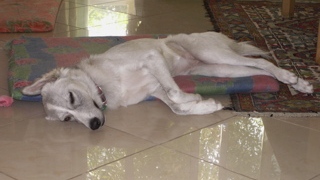
“How much exercise does my dog need?” This question sounds straightforward enough, but peel it apart and you’ll find it has several layers. Inquiring dog owners crave reassurance that they’re doing right by their dogs, meeting their needs. Also embedded in the query may be “I love my dog but…how can I get her to leave me alone when I’m trying to relax?” And sometimes, let’s be honest because we’ve all been there, it’s a plea for a manageable minimum investment of time: “Life is crazy busy, and I don’t want to short-change my dog but…how little exercise can I get away with?”
I think dog owners have heard the old saw, “A tired dog is a good dog” and are wondering how tired their dog needs to get in order to be “good”. Here’s what I tell them: First, ask your vet how much exercise is too much. She’ll discuss limits on duration and intensity specific to your dog’s health status and developmental stage. This is especially important for young dogs who are still growing, to prevent damage to their bones and joints. Then, learn to recognize the signs of too little exercise–including destructive chewing, excessive nipping and mouthiness, overly rough play, high arousal and excitability, and inability to settle. Somewhere between those extremes is the “right” amount of exercise for your dog.
But let’s really unpick this “tired dog = good dog” formula. Does it mean we need to run our dogs till they drop, so they’ll be too exhausted to misbehave? To be sure, running can be an efficient way for dogs to unwind, especially when owners work long hours and their dog greets them in the evening with a full day’s worth of crated-up energy. But not every dog needs, or wants, a strenuous cardio workout. What every dog does need is as many chances as possible to act like a dog. So in my mind, the term “exercise” encompasses all possible outlets for the naturally occurring behaviors that our dogs’ biology impels them to do.
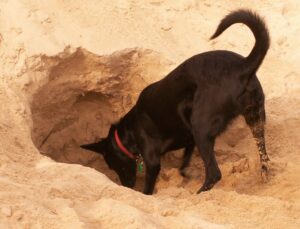
Left to their own devices, how would dogs spend their day? They’d sleep. Sniff things. Chase things. Hunt for food. Scavenge. Spend time with their people. Maybe spend time with other dogs. Play. Nap in the sun. Roam around. Dig. Rip some stuff up. Solve problems and figure stuff out. Chew on things. Explore. Roll in things. Ah…that’s a dog’s life.
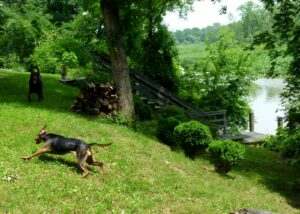
To make sure our dogs are getting enough exercise–in the broadest sense of the word–we can choose liberally and creatively from this menu. Granted, maybe I don’t want my dog letting off steam by rolling in a raccoon carcass or snacking from the neighbor’s garbage can. But most of us can come up with ways to let our dogs enjoy at least some of these natural behaviors–or adapted versions of them–both outdoors and indoors, if we put our minds to it. During each segment of your dog’s day–walk time, feeding time, play time, and downtime–there are loads of ways to encourage your dog express his authentic self and offload all his surplus energy in the process.
Walk time:
Let your dog sniff to his heart’s content–recycling bins, fire hydrants, grass, stinky things in the woods, whatever makes his tail wag. Walk him on a 20-foot long line and let him wander wherever his nose leads him. Walk him with a pal–yours and/or his. Hop in the car and drive to new places for a change of scene and scent: different neighborhoods, parks, bike paths, playgrounds, soccer fields, community gardens…anywhere other than the same dull stroll around the block. Go on a field trip to a dog friendly store–not just Petsmart and Petco but Home Depot, Lowes, Carmax, Pottery Barn, Barnes & Noble, Orvis, and a long list of others that may surprise you.
Feeding time:
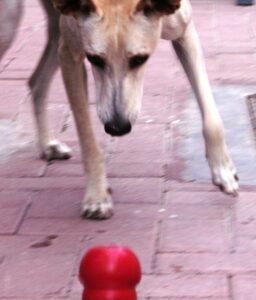
Don’t feed your dog from a bowl! It’s too easy, too fast, too boring. Research shows that dogs (and most other animals) prefer to work for their food. It’s a principle called contrafreeloading; read a smart explanation here. Dogs are hard-wired to invest a lot of physical and mental effort in procuring food, so make it challenging and fun. Split your dog’s daily ration into lots of small parcels and deliver them throughout the day in entertaining ways.
Scatter kibbles in the yard or around the house. Pour kibbles into a food dispensing toy like an IQ Ball, Kong Wobbler, or Buster Cube, or stuff just about anything edible in a Kong–see KongCompany.com for inspiration, or do what trainer and author Colleen Pelar does and stick a humble Milkbone in there and let your dog gnaw and gnaw to liberate it crumb by crumb.
Load treats or dry food into a puzzle toy, or “upcycle” your own–here are a few ideas: Drop a few bits of food into a plastic soda bottle and see how many your dog can shake loose before the bottle is crushed flat. Put some kibbles in a small box. Tape it shut and stuff it in a slightly bigger box, tape it shut, repeat with increasingly larger boxes. Now you have a treat-stuffed hand-made Russian matryoshka “doll” for your dog to eviscerate. Or grab a section of newspaper, lay down a diagonal line of kibbles from corner to corner, roll up the newspaper around the line of kibbles, tie it in a knot, toss it to your dog and let him go to town. Yes, there will be some clean-up, but it’ll be a joyful mess.
Pick up a copy of Kyra Sundance’s terrific book 10-Minute Dog Training Games. Here’s a sample: Fill a laundry basket with dog toys, and fling a handful of kibbles into it. See how long it takes for your dog to extricate the food–and what strategies he comes up with.
Play time:
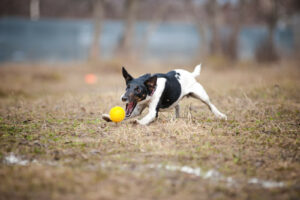
This is bonding time–and a chance for a mock hunt. You can incorporate some training cues (recalls, drop it, sit, etc.), but don’t spoil the fun. Throw things for your dog to chase–tennis balls, Jolly Balls, Frisbees, sticks, whatever excites him. It’s okay if he doesn’t bring them back; sometimes it’s just all about the hot pursuit. Toss a ball down the stairs and have your dog barrel back upstairs for the next round. Play hide and seek, inside or outside. Let your dog rip up stuffed animals now and then–not the pricey ones from the pet store, but maybe the beat up ones your kids don’t even like anymore. Give him a spot in the yard where he can dig with abandon and impunity. It’s a “project” he can go back to over and over to unearth fresh smells and scrabble for rodents. Check out Play With Your Dog by Pat Miller for more inspiration.
Safe, appropriate play with another dog can be a rewarding experience for everyone involved, but keep in mind that some dogs do “age out” of play and many prefer to play with their people over any and all canine companions.
Downtime:
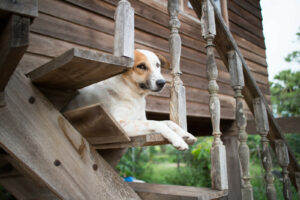
Even if your dog is on her own for long hours while you’re at work, there are ways to spice up her day. Getting her out mid-day for a walk will break up his day and stimulate his senses. Even if you just ask a neighborhood teenager to stop by after school and spend ten minutes playing outside with your dog, it counts. Leave something nice–a stuffed Kong, food toy/puzzle, hoof, compressed rawhide, small marrow bone, bully stick, or antler when you go out in the morning, and have your dog walker dole out another one when she departs.
Once your dog is fully house-trained, try to reduce time spent in the crate–or eliminate it altogether. Given a little freedom, she has a chance to find a sunny spot for a snooze, and peer out the window and watch the world go by. If the weather allows, leave the windows open so interesting smells can waft in.
Fellow trainers, how do you answer the exercise question? Fellow dog owners, how do you make sure your dog gets enough? And how can you tell when she doesn’t?
